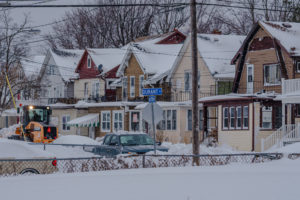By Lori White
A recent article by the Washington Post attempted to answer the question, “Why was this storm so deadly?” While hindsight is always 20/20, there’s a grit and perseverance in Buffalonians that makes them suspicious when it comes to the pre promotion of “big” weather events. However, given that weather reporting is becoming much more sophisticated and on target, and we have had two historic storm systems move through our area in the span of a month, I think attitudes are changing.
As the snow begins to melt, and the government gets back to the routine workings, citizens are calling for time to be spent analyzing the storm response, and (most importantly) updated measures for storm response in the future. Here are a few suggested agenda topics:
Corporate policies, despite a blizzard advisory Friday morning many companies (some feeling the pinch for last minute holiday shopping and food orders) did not shut down. Typically, it’s been corporate policies to wait until government officials issue driving bans to determine if they will be open.
Earlier and more frequent driving bans. For this storm, weather officials were warning all week that this would be a historic storm. Officials knew well in advance that it would hit our region at 7 am. Should government officials have issued the driving ban at 7 am Friday morning, proactively as opposed to what appears to be a “wait and see” how bad the storm is policy? With the understanding that residents have warning fatigue and many adopt a “they can’t tell me what to do” attitude. This is one policy that should absolutely be revisited, with more people able to do their jobs from home, and a system that has defined essential workers, the county, city, and towns could more focus their efforts on making sure this group of workers were in place earlier, with plans for relieving first responders and essential shift workers.
Weather experts are saying that we are likely to see more severe storms like the Blizzard of 2022. With an aging infrastructure, and outdated technology and policies, maybe it’s time to relook at the following:
FIX AND UPDATE THE POWER GRID in the city of Buffalo, especially on the East and West sides. During my time working for a utility I saw many clear hazards– power lines draped with tree branches, poles that were inaccessible, and general neglect. Why does the power go out in wind, rain and snow? Because of wind, rain, and snow! Bury new utility lines with accessible conduits for upgrades and additional services.
HOLD LANDLORDS ACCOUNTABLE: especially out-of-town owners. It’s time for government officials to put some teeth in the rules and also give landlords the right to evict tenants not taking care of their property – broken windows, leaky roofs, improper insulation, electrical and HVAC systems that have not been serviced or updated.
EMERGENCY RESPONSE PLANS: We need a better emergency plan that involves helpful activation before weather events, not more command centers. Also, so much taxpayer money goes to nonprofits and organizations that serve vulnerable communities and when all those services close up for the holiday those same communities have no resources. Orgs that receive public money should submit a plan of record to open in the event of a crisis, with additional essential stock of baby formula, dry, and canned goods.
COMMUNITY CENTERS/WARMING CENTERS SHOULD NEVER LOSE POWER before next winter inspect every one with an industry expert and allocate funds for upgrades and generators out of Build Back Better funds.
EVERY WNY MUNICIPALITY SHOULD HAVE A ROOK OF THEIR OWN & snowmobiles – How about interest-free financing for snowmobiles for first responders?
TABLE THE CLIMATE ACT: incentivize clean tech innovation that can be quickly scaled up for regular everyday use but don’t make people switch, give them a better, affordable option.
COORDINATE ROUTE TRACKING: my school district does it for busses – talk to them about hooking up the same thing for plows.
RIDE SHARING AND ACTIVATION LIST: for private contractor snow plows, the county can run dispatch on emergency clean up or preparation.
EMERGENCY COMMUNICATION SYSTEMS: each town has to have a better emergency communication system than Facebook! Emergency texting? Again, school districts do it pretty well, how do we make this more wide-scale?
PUBLIC TRANSPORTATION: Focus on Public Transportation over Cars, make narrow city roads passable for all citizens quicker with less focus on vehicle traffic in the immediate aftermath of a storm meaning more buses along major routes, invest in light rail.
Most importantly, our community is filled with helpers, have a plan in place and a CALL TO ACTION for residents that are willing and able to help with their shovels and snowblowers if possible and dispatch them to subway and bus routes throughout the city.
This is not intended to be a comprehensive list, but a start of one based on personal observations – Do you have any items you think should be added? List them in the comments below.
Photo by Vincent Berbano
The post It’s time to look at our regional Storm Response: aging infrastructure, outdated technology, and ineffective policies were all contributing factors in this dangerous and deadly storm appeared first on Buffalo Rising.

